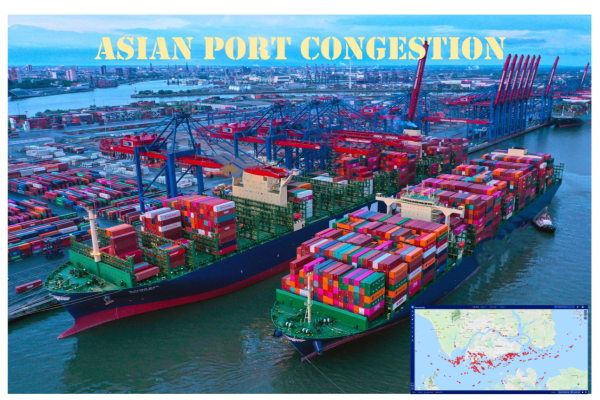Port congestion has returned to plague container markets, with Singapore being pinpointed as the current epicentre of the backlogs, according to a new report from Asian container consultancy Linerlytica. They note that berthing delays are now up to seven days at the world’s second largest container port, with the total capacity waiting to berth rising to 450,000 TEU in recent days.
Globally, Linerlytica estimates that two million TEU of ship capacity, or 7% of the available global fleet, is now caught in congestion.
A separate report from the Bank of America cites Singapore, Dubai and the Mediterranean as congestion hot spots and note that “Asian box availability remains tight.”
In Singapore, where authorities have temporarily reopened the shuttered Keppel Terminal to alleviate vessel queues, there are 56 container vessels. The bottlenecks have caused some operators, including CMA CGM, to skip Singapore calls. That said, there is now about 380,000 TEU of delayed vessels in Singapore, compared with 450,000 TEU last week.
“The severe congestion has forced some carriers to omit their planned Singapore port calls, which will exacerbate the problem at downstream ports that will have to handle additional volumes,” Linerlytica pointed out.
The delays have resulted in what they call ‘vessel bunching.’ Shanghai and Qingdao are also experiencing a huge build-up of containerships at anchor. ‘Dwell times’ at Shanghai, the world’s largest container port, are now at three-year highs. Ships have had to wait as long as five days to berth in Shanghai, where logjams are at their highest since Covid.
S&P vessel-tracking data shows 50 containerships in Shanghai, including at anchorage. Some, like the Cosco Shipping Mexico and CMA CGM Big Sur, have been in the port since last week.
S&P also shows 51 containerships in Port Klang. Ports in south-east and north-east Asia are still the most congested, accounting for 29% and 23% of vessel queues worldwide.
Analysts have warned that extra transit times come inevitably as vessels are forced to divert around South Africa on their normal Asia to Europe runs, due to the Red Sea Crisis. Now, with the Houthi threatening to expand their activities further afield – including into the Indian Ocean – carriers have been warned to ensure that their vessels increase the diversions, meaning even longer distances and greater travel times.
Another market intelligence firm, Sea-Intelligence, recently reported that transit times on the most popular routes were all seeing increases in times, but that the worst is to the Mediterranean ports, where in many cases carriers have been transhipping containers through ‘intermedia ports’ since they are diverting away from the Suez Canal. According to Sea-intelligence, transit times during the first three months of 2024 increased on average by 39% on the most popular route pairings between Asia and the Mediterranean, while it also only slightly less with a 15% increase for port pairings between Asia and Northern Europe.
As these pressures grow, they are contributing to sudden increases in shipping costs. Several reports have warned that prices are returning to pandemic levels as a new wave of port congestion moves through many segments of the market.
Read this related article: Expect Shipping Delays Via Singapore
For the latest information about international shipping trends, contact us here at Colless Young. As licensed Customs Brokers and Freight Forwarders we offer correct, professional advice on all your transportation requirements. We are based in Brisbane and provide a complete range of logistics services, both airfreight and sea cargo, through all Australian ports and airports.

